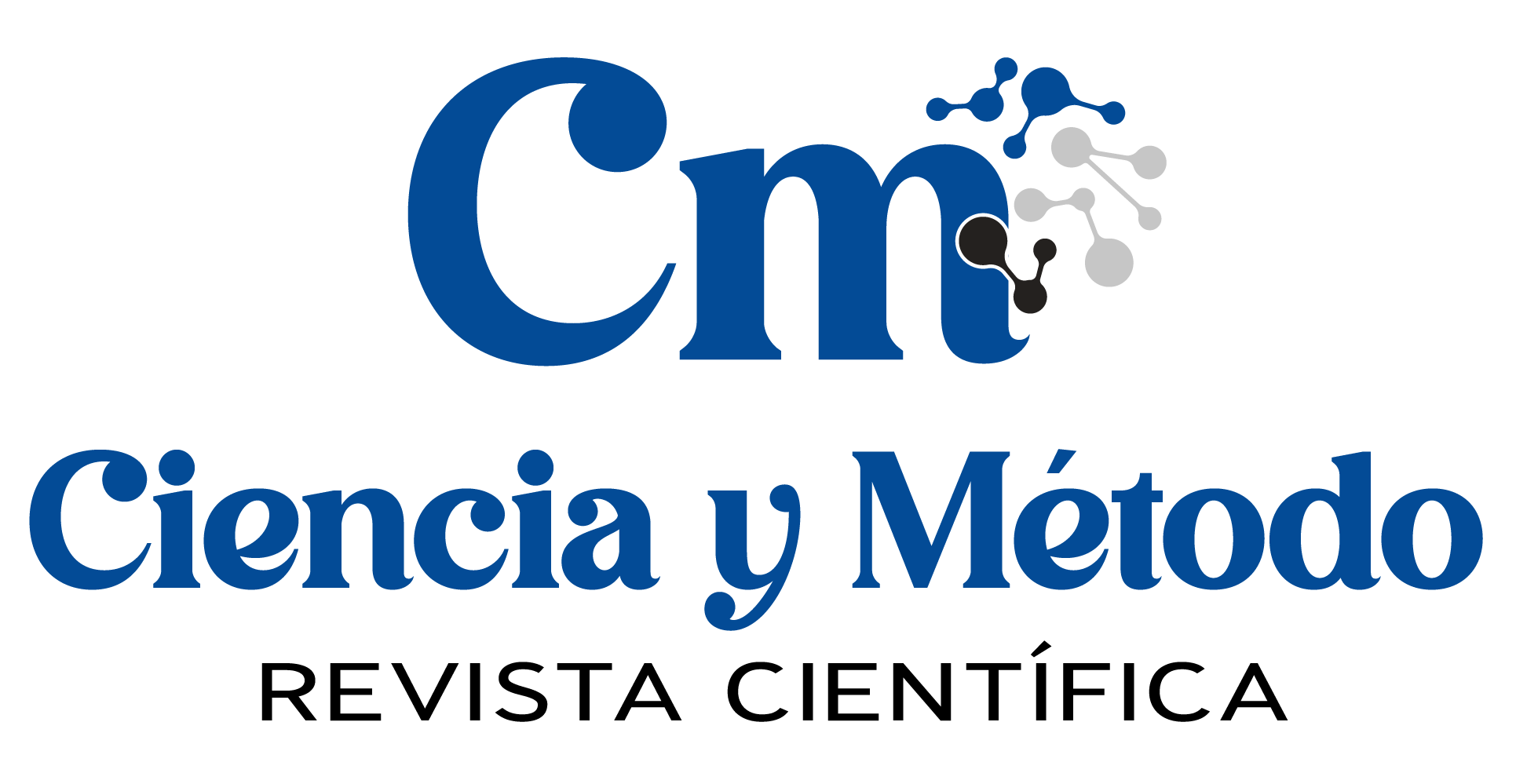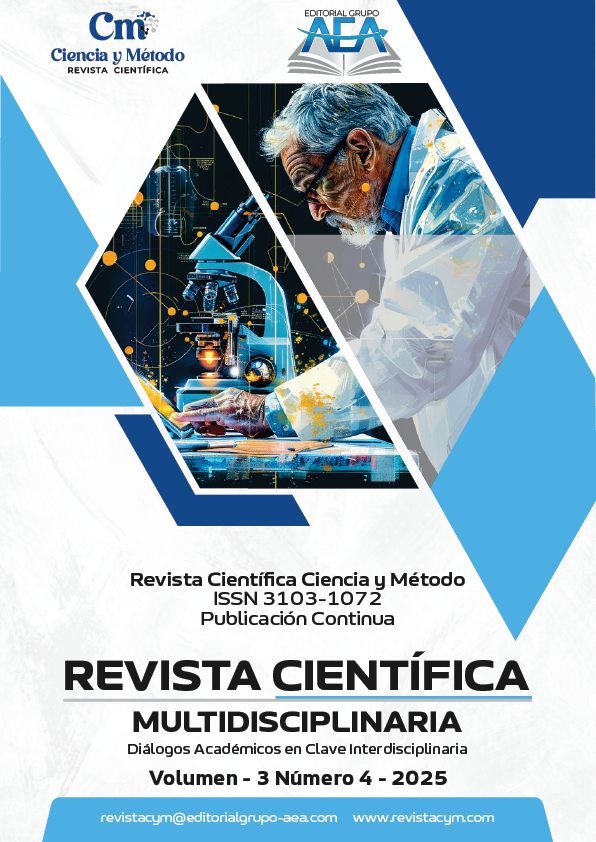Evaluation of the bioremediation potential of microorganisms isolated from soils impacted by hydrocarbons.
Main Article Content
Abstract
Soil contamination by hydrocarbons represents a critical environmental challenge due to its persistence, toxicity, and effects on human health and ecosystems. In this context, this research evaluates the bioremediation potential of microorganisms isolated from hydrocarbon-contaminated soils through a systematic, exploratory, and qualitative literature review. Scientific articles published between 2013 and 2024 addressing the isolation, characterization, and application of bacteria, fungi, and microbial consortia in degradation processes were analyzed. The results indicate that bacterial genera such as Pseudomonas, Rhodococcus, and Alcanivorax stand out for their effectiveness in degrading aliphatic and aromatic hydrocarbons, while filamentous fungi, such as Pleurotus and Aspergillus, possess oxidative enzymes capable of transforming recalcitrant compounds. Likewise, microbial consortia show greater metabolic synergy than individual strains, optimizing biodegradation. Factors such as pH, temperature, humidity, nutrients, and bioavailability of the contaminant have a decisive influence on the efficiency of the process. It is concluded that the integration of strategies such as biostimulation, bioaugmentation, and the use of biosurfactants, combined with the rational design of microbial consortia, offers a sustainable and effective way to recover soils impacted by hydrocarbons.
Downloads
Article Details
Section

This work is licensed under a Creative Commons Attribution-NonCommercial 4.0 International License.
How to Cite
References
Atlas, R. M. (1981). Microbial degradation of petroleum hydrocarbons: An environmental perspective. Microbiological Reviews, 45(1), 180–209. https://doi.org/10.1128/mr.45.1.180-209.1981 DOI: https://doi.org/10.1128/mr.45.1.180-209.1981
Atuchin, V. V., Kirichenko, M. N., Zakharova, I. A., Kondrateva, T. F., & Shapovalov, Y. V. (2023). Microorganisms for bioremediation of soils contaminated by hydrocarbons. Microorganisms, 11(4), 864. https://doi.org/10.3390/microorganisms11040864 DOI: https://doi.org/10.3390/microorganisms11040864
Campuzano-Santana, K. L., Alarcón-Giraldo, V. D. ., & España-Lema, A. I. . (2025). Evaluación ambiental de sistemas agrícolas y forestales mediante análisis poblacional de nematodos como bioindicadores. Journal of Economic and Social Science Research, 5(2), 132-143. https://doi.org/10.55813/gaea/jessr/v5/n2/193 DOI: https://doi.org/10.55813/gaea/jessr/v5/n2/193
Chacaguasay-Apugllon, E. N., Sánchez-Quiñonez, D. F., Gavilánez-Buñay, T. C., & Rivera-Toapanta, E. A. (2025). Concentración de fenoles totales y flavonoides en fabáceas forrajeras y arbustivas y uso como bioestimulante. Revista Científica Zambos, 4(1), 30-44. https://doi.org/10.69484/rcz/v4/n1/74 DOI: https://doi.org/10.69484/rcz/v4/n1/74
Chicaiza-Ortiz, C. D., Rivadeneira-Arias, V. del C., Herrera-Feijoo, R. J., & Andrade, J. C. (2023). Biotecnología Ambiental, Aplicaciones y Tendencias. Editorial Grupo AEA. https://doi.org/10.55813/egaea.l.2022.25 DOI: https://doi.org/10.55813/egaea.l.2022.25
Chicaiza-Ortiz, C. D., Rivadeneira-Arias, V. del C., Herrera-Feijoo, R. J., & Andrade, J. C. (2023). Guía de Biotecnología Ambiental. In Biotecnología Ambiental, Aplicaciones y Tendencias (pp. 6–71). Editorial Grupo AEA. https://doi.org/10.55813/egaea.cl.2022.16 DOI: https://doi.org/10.55813/egaea.cl.2022.16
Chicaiza-Ortiz, C. D., Rivadeneira-Arias, V. del C., Herrera-Feijoo, R. J., & Andrade, J. C. (2023). Prácticas de laboratorio y cuestionario sobre biotecnología ambiental. In Biotecnología Ambiental, Aplicaciones y Tendencias (pp. 92–117). Editorial Grupo AEA. https://doi.org/10.55813/egaea.cl.2022.18 DOI: https://doi.org/10.55813/egaea.cl.2022.18
CLU-IN. (2006). Phytotechnology Project Profiles: Phytoremediation of Organic Contaminants. U.S. Environmental Protection Agency (EPA). Technology Innovation Office. https://clu-in.org/download/remed/phytotechnologies.pdf
Corral-García, L. S., Ugarte-Ruano, A., & Belda-Ferre, P. (2024). Bacterial diversity in old hydrocarbon polluted sediments from the Ecuadorian Amazon river basins. Microorganisms, 12(2), 119. https://doi.org/10.3390/microorganisms12020119 DOI: https://doi.org/10.3390/toxics12020119
Correa-Salgado, M. de L., Herrera-Feijoo, R. J., Ruiz-Sánchez, C. I., & Guamán-Rivera, S. A. (2024). Fundamentos de Bioquímica Vegetal. Editorial Grupo AEA. https://doi.org/10.55813/egaea.l.68 DOI: https://doi.org/10.55813/egaea.l.68
Covino, S., Svobodová, K., Cvancarová, M., D’Annibale, A., & Cajthaml, T. (2016). In vivo and in vitro bioremediation of diesel fuel-contaminated soil by Pleurotus ostreatus. Environmental Science and Pollution Research, 23(14), 14214–14226
Crespo-Gutiérrez, R. S., Jiménez-Romero, E. M., Anchundia-García, J. J., Jara-Minaya, J. M., & Mora-Silva, W. F. (2025). Propiedades físicas y mecánicas de la madera de Ochroma pyramidale (Cav. ex Lam.) Urb. (balsa) creciendo en tres localidades ecuatorianas. Revista Científica Ciencia Y Método, 3(3), 364-384. https://doi.org/10.55813/gaea/rcym/v3/n3/81 DOI: https://doi.org/10.55813/gaea/rcym/v3/n3/81
Das, N., & Chandran, P. (2011). Microbial degradation of petroleum hydrocarbon contaminants: An overview. Biotechnology Research International, 2011, 941810. https://doi.org/10.4061/2011/941810 DOI: https://doi.org/10.4061/2011/941810
Del Corral-Villarroel, V. H., Sucoshañay-Villalba, D. J., Álvarez-Cortez, L. E., Mejía-Pazmiño, L. A., & Montero-Garofalo, M. F. (2024). Amazonía Biodiversa: Explorando el Potencial del Turismo Ecológico Sostenible. Editorial Grupo AEA. https://doi.org/10.55813/egaea.l.111 DOI: https://doi.org/10.55813/egaea.l.111
El-Naas, M. H., Acio, J. A., & El Telib, A. E. (2014). Aerobic biodegradation of BTEX: Progresses and prospects. Journal of Environmental Chemical Engineering, 2(2), 1104–1122. https://doi.org/10.1016/j.jece.2014.04.009 DOI: https://doi.org/10.1016/j.jece.2014.04.009
Enell, A., Reichenberg, F., Ewald, G., & Warfvinge, P. (2005). Desorption kinetics studies on PAH-contaminated soil under varying temperatures. Chemosphere, 61(10), 1529–1538. https://doi.org/10.1016/j.chemosphere.2005.04.104 DOI: https://doi.org/10.1016/j.chemosphere.2005.04.092
Fathepure, B. Z. (2014). Recent studies in microbial degradation of petroleum hydrocarbons in hypersaline environments. Frontiers in Microbiology, 5, 173. https://doi.org/10.3389/fmicb.2014.00173 DOI: https://doi.org/10.3389/fmicb.2014.00173
Ghosal, D., Ghosh, S., Dutta, T. K., & Ahn, Y. (2016). Current state of knowledge in microbial degradation of polycyclic aromatic hydrocarbons (PAHs): A review. Frontiers in Microbiology, 7, 1369. https://doi.org/10.3389/fmicb.2016.01369 DOI: https://doi.org/10.3389/fmicb.2016.01369
Harms, H., Schlosser, D., & Wick, L. Y. (2011). Untapped potential: Exploiting fungi in bioremediation of hazardous chemicals. Nature Reviews Microbiology, 9(3), 177–192. https://doi.org/10.1038/nrmicro2519 DOI: https://doi.org/10.1038/nrmicro2519
Harris, K. L., et al. (2013). Bioaccessibility of polycyclic aromatic hydrocarbons. Environmental Pollution, 182, 1–23. https://www.ncbi.nlm.nih.gov/pmc/articles/PMC4081012/
Herrera-Feijoo, R. J. (2024). Principales amenazas e iniciativas de conservación de la biodiversidad en Ecuador. Journal of Economic and Social Science Research, 4(1), 33–56. https://doi.org/10.55813/gaea/jessr/v4/n1/85 DOI: https://doi.org/10.55813/gaea/jessr/v4/n1/85
Herrera-Feijoo, R. J., Chicaiza-Ortiz, C. D., Rivadeneira-Arias, V. del C., & Andrade, J. C. (2023). Análisis bibliométrico como una herramienta en la biotecnología ambiental. In Biotecnología Ambiental, Aplicaciones y Tendencias (pp. 72–91). Editorial Grupo AEA. https://doi.org/10.55813/egaea.cl.2022.17 DOI: https://doi.org/10.55813/egaea.cl.2022.17
Huera-Lucero, T., Abad, M. F., Carrillo-Rosero, R., et al. (2025). Soil quality indicators for different land uses in the Ecuadorian Amazon. Forests, 16(8), 1275. https://doi.org/10.3390/f16081275 DOI: https://doi.org/10.3390/f16081275
Huera-Lucero, T., Bravo-Montoya, M., Calizaya-Quispe, M., & Maza-Álvarez, M. (2020). A framework to incorporate biological soil quality indicators into assessing the sustainability of territories in the Ecuadorian Amazon. Sustainability, 12(7), 3007. https://doi.org/10.3390/su12073007 DOI: https://doi.org/10.3390/su12073007
Intriago-Villavicencio, J. S., Vera-Bravo, M. Y., Vargas-Castillo, J. L., & Aguirre-Mite, F. A. (2025). Análisis de las variaciones morfométricas del campeche (Chaetostoma fischeri) en poblaciones de dos regiones del Ecuador. Revista Científica Ciencia Y Método, 3(3), 351-363. https://doi.org/10.55813/gaea/rcym/v3/n3/80 DOI: https://doi.org/10.55813/gaea/rcym/v3/n3/80
Jindrová, E., Chocová, M., Demnerová, K., & Brenner, V. (2002). Bacterial aerobic degradation of benzene, toluene, ethylbenzene and xylene. Folia Microbiologica, 47(S2), 83–93. https://doi.org/10.1007/BF02817664 DOI: https://doi.org/10.1007/BF02817664
Kebede, G., Tufa, T. B., & Deyou, T. (2021). Factors influencing the bacterial bioremediation of hydrocarbon contaminants. Scientifica, 2021, 9823362. https://doi.org/10.1155/2021/9823362 DOI: https://doi.org/10.1155/2021/9823362
Kumar, M., Dwivedi, S., Srivastava, S., & Kumar, R. (2019). Biodegradation of petroleum hydrocarbons through microbial approach: A review. Environmental Technology & Innovation, 13, 275–286.
Kumar, V., Raina, M., & Sharma, S. (2022). Synthetic microbial consortia: Engineering and applications in biodegradation. Biotechnology Reports, 33, e00714.
Lamichhane, S., Bal Krishna, K. C., & Sarukkalige, R. (2016). Polycyclic aromatic hydrocarbons (PAHs) removal by sorption: A review. Chemosphere, 148, 336–353. https://doi.org/10.1016/j.chemosphere.2016.01.036 DOI: https://doi.org/10.1016/j.chemosphere.2016.01.036
Ławniczak, Ł., Włodarczyk, K., & Juzwa, W. (2020). Microbial degradation of hydrocarbons–basic principles for bioremediation: A review. Molecules, 25(4), 856. https://doi.org/10.3390/molecules25040856 DOI: https://doi.org/10.3390/molecules25040856
Lee, Y., Lee, Y., & Jeon, C. O. (2019). Biodegradation of naphthalene, BTEX, and aliphatic hydrocarbons by Paraburkholderia aromaticivorans BN5 isolated from petroleum-contaminated soil. Microbial Cell Factories, 18, 110. https://doi.org/10.1186/s12934-019-1164-9 DOI: https://doi.org/10.1038/s41598-018-36165-x
Mihai, R. A., Sánchez, D. Y., Cuzme-García, R. A., et al. (2023). The panoramic view of Ecuadorian soil nutrients (deficit/excess) and soil management strategies. Plants, 12(3), 543. https://doi.org/10.3390/plants12030543 DOI: https://doi.org/10.3390/plants12030543
Patel, A. B., Shaikh, S., Jain, K. R., Desai, C., & Madamwar, D. (2020). Polycyclic aromatic hydrocarbons: Sources, toxicity, and remediation approaches. Frontiers in Microbiology, 11, 562813. https://doi.org/10.3389/fmicb.2020.562813 DOI: https://doi.org/10.3389/fmicb.2020.562813
Radhakrishnan, A., Balaganesh, P., Vasudevan, M., Natarajan, N., Chauhan, A., Arora, J., Ranjan, A., Rajput, V. D., Sushkova, S., Minkina, T., Basniwal, R. K., Kapardar, R., & Srivastav, R. (2023). Bioremediation of Hydrocarbon Pollutants: Recent Promising Sustainable Approaches, Scope, and Challenges. Sustainability, 15(7), 5847. https://doi.org/10.3390/su15075847 DOI: https://doi.org/10.3390/su15075847
Wu, M., Li, W., & Dick, W. A. (2016). Bioaugmentation and biostimulation of hydrocarbon degradation in petroleum-contaminated soil: A review. Journal of Environmental Management, 172, 190–199. https://doi.org/10.1016/j.jenvman.2016.02.013 DOI: https://doi.org/10.1016/j.jenvman.2016.02.013
Yu, L., Zhang, B., Liu, J., & Zhang, N. (2018). Abiotic factors controlling bioavailability and bioaccessibility of soil PAHs: A review. Science of the Total Environment, 631–632, 1170–1183. https://doi.org/10.1016/j.scitotenv.2018.03.082 DOI: https://doi.org/10.1016/j.scitotenv.2018.03.082





